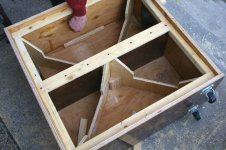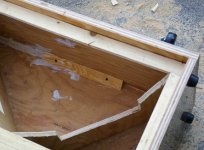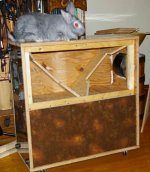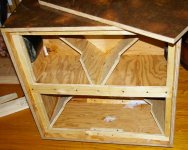Another reason not to try to use them for bass,
if you want the freedom to play anything, any style...
Obviously this won't be true for bass.
As someone pointed out, even marginally less sensitive speakers (i.e. bass speakers) will require far more power,
and you have to double the air-movement or excursion for each octave, multiplying the actual power needed by x 16 (?) or so...
So to do that with a bass means more like a 300-600 watt amp, and for a safety margin, say at least 300-500 watt speakers...
--------------------------------------------------------
Celestion Vintage 30
$145 each sale price.... (x 4 = $600 !!! no bargains here)...
hmmm.... according to this discussion, the V-30 is Celestion's own high power version of the Blueback, so why bother?
Might as well let Celestion give us their best version of the same sound.
Also, ask yourself: Why did they feel they needed to copy the exact same sound,
but only as a 60 watt version?
- Because even for guitar, 240 watts was deemed some kind of minimum rating,
for warrantee and support purposes. They ain't gonna refund money to a bunch of airheads,
who take 15-25 watt speakers and pump in 100 watts per cabinet.
An externally hosted image should be here but it was not working when we last tested it.
This looks like a 'cover your ***' engineering and marketing decision.
What's a guitarist to do?
- Tone of Celestion Blue with more power handling
- 60W power rating (handling 3 times the power)
- 100db sensitivity (needing less power too)
- Round copper voice coil (cheap coil)
- Ceramic magnet (cheap magnet)
- 70-5kHz frequency range (same range).
Get a better price-point in USA-made speaker!
Keep jobs here, and quit giving your hard earned cash to the Chinese,
who need your money like a hole in the head....

Celestion are british..... cheap models made in china (as is everything nowadays, including 'American' products.....) But to the best of my knowledge (ie I MAY be wrong) the reissue/classic stuff is still UK made. The greenback/blueback is the definitive/first ever guitar speaker made by celestion, as a result, EVERYTHING else is going to be loosely based on it.
Youre most peculiar question is WHY would they try to carry the SAME sound through the newer, updated range?
Probably, because the Marshall/celestion guitar sound is the most famous, most popular sound, and they wish to keep their clientele???
Personally I do not like the G12T75 at all, hence why I got the greenbacks, which were used in other iconic amps of the 60-70s era. The bluebacks were IIRC used in the Vox AC15 and AC30 amps, a la Bryan May of Queen. I have used eminence drivers, and whilst they are well built, I dont like the sound of those either. Fane sound good, better on solid CLEAN guitar. But man are they expensive.
240W for guitar? you crazy? the most commonly used marshall heads are 90W and less, only the high end stuff goes to 120W IIRC, and for a 12" woofer with the same Xmax, the power handling is way less important, since youll run out of PHYSICAL headroom, long before you burn the coil out. 240W is no good if the cab only plays clean to 90W.
Yes you need more power for bass. If you want your amp to do both, the solution is simple: get 2 amps and cabs
If you want to stay 'US' maybe use a Fane driver(I believe theyre still US made) but itll cost you twice the celestion, and not sound anything like a marshall.
Last edited:
Yes you need more power for bass. If you want your amp to do both, the solution is simple: get 2 amps and cabs
I honestly don't believe this is necessary.
My set-up is as follows:
Laney G300 head (stereo amplifier, 150w/ch @4ohm, can be bridged to give 1.2kW peak output - stupid loud - the cabinet is >100dB @1w).
The cabinet has a single wide-range driver, the rest being conventional PA midbasses. It's 4x10", sealed. Around 80L internal. The system as a whole has a reasonably flat frequency response from 80Hz-10kHz. Rolls off slowly at each end, allowing room for boosting to give an extended response.
With the 10 band graphic eq on my amp, I can dial in any sound I want, bass, guitar, or even as a reasonably powerful (mono) PA system.
For guitar, I put several dBs of boost at 1-5kHz, emulating the frequency response of a typical guitar speaker.
For bass, I usually set it for a flat response, and tweak to taste depending on room and desired sound.
Chris
Now supposing I were to put just two 12" bass speakers in this cabinet.
The question then becomes, just where should they go?
The most significant alignment has to do with the distance from the floor.
I found this interesting bit of info on distance of speaker to floor:
Height: 30 cm > 600 Hz (1st cancellation at approximately 1200 Hz).
Height: 10 cm > 1800 Hz (1st cancellation at approximately 3600 Hz).
(the upper position in my 4 x 12" cab is about 23", or 55 cm) >= 700 Hz?)
Judging from this tidbit, it looks like I could fine-tune
the response just a bit further,
by mounting the speakers high enough from the floor,
to say reinforce at the low B or just above it on a 5-string!
I don't know how he is calculating this,
but it looks like an approximate curve could be extended to say 40 Hz, and maybe the speaker would still be inside the cabinet!
Oops nevermind: actually it looks like I'd have to position the cabinet about 2-3 feet off the ground!
In the lower position (about 7" from floor) it looks like maybe a 5kHz boost!
The question then becomes, just where should they go?
The most significant alignment has to do with the distance from the floor.
I found this interesting bit of info on distance of speaker to floor:
Height: 70 cm > 250 Hz (1st cancellation at approximately 500 Hz).Optimum frequency response curves in the bass range.
a. The influence of the floor reflection
Depending on the woofers' height over the floor, the contribution from the floor will be in phase with the direct radiation from the driver up to a higher or lower frequency. Some examples are shown below.
Height: 70 cm (29 in") > 250 Hz (1st cancellation at approximately 500 Hz).
Height: 30 cm (11.8") > 600 Hz (1st cancellation at approximately 1200 Hz).
Height: 10 cm > 1800 Hz (1st cancellation at approximately 3600 Hz).
Below this frequency the level will be elevated approximately 2-6 dB compared to higher frequencies. To be more specific, the level is elevated 6 dB when the reflection is in phase with the direct radiation and, on an average, it is elevated 3 dB in the higher range where the reflection appears in random phase.
Both the 6 dB increase at low frequencies and the 3 dB increase at higher frequencies can be less depending on how elastic the reflective surface is (for low frequencies) and how absorbing it is (for high frequencies). Therefore, the interval is 2-6 dB.
b. The cavity effect of the room
Real rooms contribute with more bass increase than if they had been a "theatre box" open in the front (this is not a "Voice of the Theatre" speaker box, but the place you sit in a theatre). In practice, there are of course many variations between different listening rooms, but it is possible to draw a "typical room curve". From it you can also see some typical floor modifications.
An externally hosted image should be here but it was not working when we last tested it.
Comments: The influences of the standing waves in the room are not included in these curves for several reasons. Firstly, they belong to the listener's acoustic in the "theatre box". Secondly, there are no "general standing waves"; all rooms are unique. It should also be pointed out that a room-adapted speaker will have an inverted frequency response compared with these curves. You can also see that you do not have to worry about the floor reflection if the woofer is placed low to the ground and the midrange is placed high and the crossover point is placed between the floor knees of the two drivers. You should, however, see to it that the woofer has 2-4 dB less output in its free field response, without the help from the floor.
Height: 30 cm > 600 Hz (1st cancellation at approximately 1200 Hz).
Height: 10 cm > 1800 Hz (1st cancellation at approximately 3600 Hz).
(the upper position in my 4 x 12" cab is about 23", or 55 cm) >= 700 Hz?)
Judging from this tidbit, it looks like I could fine-tune
the response just a bit further,
by mounting the speakers high enough from the floor,
to say reinforce at the low B or just above it on a 5-string!
I don't know how he is calculating this,
but it looks like an approximate curve could be extended to say 40 Hz, and maybe the speaker would still be inside the cabinet!
Oops nevermind: actually it looks like I'd have to position the cabinet about 2-3 feet off the ground!
In the lower position (about 7" from floor) it looks like maybe a 5kHz boost!
Last edited:
What's a guitarist to do?
Get some real world listening experience to temper your false assumptions based on what you've read.
For instance, a V30 sounds nothing like a Celestion Blue.
Greenbacks are highly prized for the way they distort. Their distortion smooths out the rattiness of tube amp, especially one overdriven by a solid state stompbox, providing a final filter in the signal chain that for many is the answer to achieving those glorious classic tones to which many of us aspire. Many guitarists spend years practicing, and gobs of money on various bits of kit, before they come to this simple realisation. Myself, I happily spend $200 a speaker for Jim Seavall's Scumback M75s. They are boutique clones of the best pre-Rola Greenbacks. (Jim bought over 400 Greenbacks to find the best, then dismantled one to learn its secrets.)
You could go through dozens of Stratocasters, numerous, nay, numberless stompboxes, and a large pile of amps seeking Hendrix's tone, or you could simply buy a WGS Reaper 55. You won't get the chunka, chunka, thump of '80s metal bands without a quad of V30s. For some tones, you absolutely need EVM-12Ls.
Don't be like the guy insisting there's no reason to spend the money on audiophile speakers - his Bose Wave radio plays all the notes quite clearly. Audiences may not even know what key you're playing in, and not everyone appreciates fretboard gymnastics, but they all can tell when the tone so sweet that even a single note gives them goosebumps. The whole idea of playing music is to get people to move their feet - and hopefully, not towards the door. 🙂
In short, you're overthinking all this, and while it may be an amusing distraction, there's no substitute for building a box and then dealing with fixes. Because, no matter what you think, that's what you're going to do.
Get some real world listening experience to temper your false assumptions based on what you've read.
For instance, a V30 sounds nothing like a Celestion Blue.
Greenbacks are highly prized for the way they distort. Their distortion smooths out the rattiness of tube amp, especially one overdriven by a solid state stompbox, providing a final filter in the signal chain that for many is the answer to achieving those glorious classic tones to which many of us aspire. Many guitarists spend years practicing, and gobs of money on various bits of kit, before they come to this simple realisation. Myself, I happily spend $200 a speaker for Jim Seavall's Scumback M75s. They are boutique clones of the best pre-Rola Greenbacks. (Jim bought over 400 Greenbacks to find the best, then dismantled one to learn its secrets.)
You could go through dozens of Stratocasters, numerous, nay, numberless stompboxes, and a large pile of amps seeking Hendrix's tone, or you could simply buy a WGS Reaper 55. You won't get the chunka, chunka, thump of '80s metal bands without a quad of V30s. For some tones, you absolutely need EVM-12Ls.
Don't be like the guy insisting there's no reason to spend the money on audiophile speakers - his Bose Wave radio plays all the notes quite clearly. Audiences may not even know what key you're playing in, and not everyone appreciates fretboard gymnastics, but they all can tell when the tone so sweet that even a single note gives them goosebumps. The whole idea of playing music is to get people to move their feet - and hopefully, not towards the door. 🙂
In short, you're overthinking all this, and while it may be an amusing distraction, there's no substitute for building a box and then dealing with fixes. Because, no matter what you think, that's what you're going to do.
+1 chris and keriwena thank you for correcting me. Dont celestion claim thats the bluebacks origin? Maybe naively i picked that up somewhere. I havent actually used that driver lol. A fullrange maybe a good combo anp solution, and i dont doubt it works, and could be a good solution to the OP. i just love the tone of my 4x10 g10s and the particular head i use. I have to dial the bass almost to off to get the lead tone i like. I dont doubt it could do bass guitar but im not sure how clean it would stay. I used to play thru a solid state keyboard combo and a fender bassman cab and it sounded great. Personally id love to just build a horn for a single g10 or other, see what gain i can get.
Last edited:
Well, forums are for opinions, and I want them,
thats the whole reason I started a thread.
Here is my build update:
Pic 1 shows me adding a permanent divide between the two sides.
This allows one 12" bass speaker to drive each side, and have its own box.
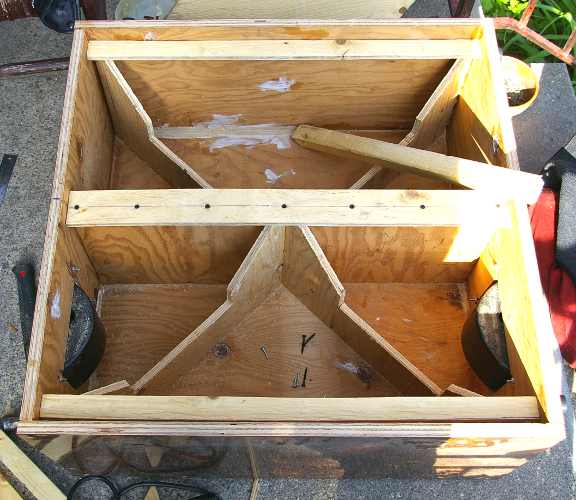
The divider is also 1" plywood from the same sheet of laminated tabletop I got free.
This makes the two sides totally independent, and also allows lots of glue-surface
and screw-down wood to sink into to hold both the front and back panels rigid,
and attached to each other across the center.
Pic 2 shows 2x2 (really 1.5 x 1.5" pine/spruce along the top and bottom edge
for sealing and screwing down the front plate(s).
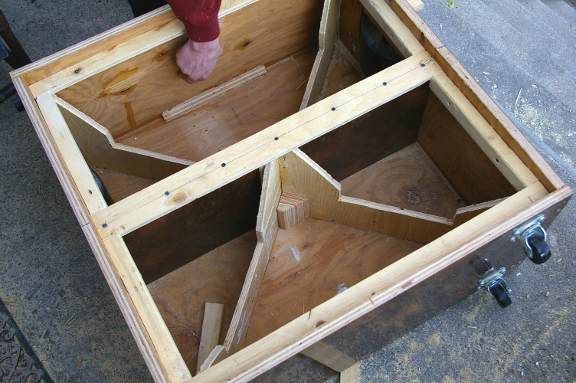
Note also the chunk of 2" plywood triangle in the center back,
to give the screws on the back panel something to bite into.
Pic 3 shows a detail of some triangular glued supports to keep the sides and back connected.

Pic 4 below shows how a half-panel can be easily substituted to make the cabinet bass/guitar combo,
or for comparing different guitar speaker-pairs.
Panels can be put in vertically or horizontally, so for instance,
I only have to cut 2 12" holes, one in each panel to have a complete bass cabinet.
Extra panels are easy to make, for swapping in and out!
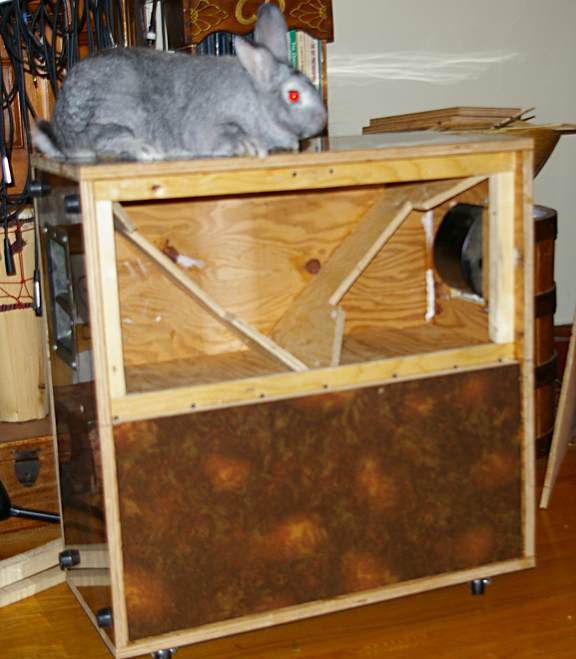
You will notice the rabbit has expressed his usual dim view of speaker projects.
In fact he is quite unimpressed with the slippery top, although it is water-proof,
and probably rabbit-proof too.
Pic 5 shows the bottom panel (same as top). They receive some stiffness from the side supports, but tapping various sides and compartment walls will reveal rattles, weak gluing, unusual resonance problems and/or areas needing more stiffness/support.
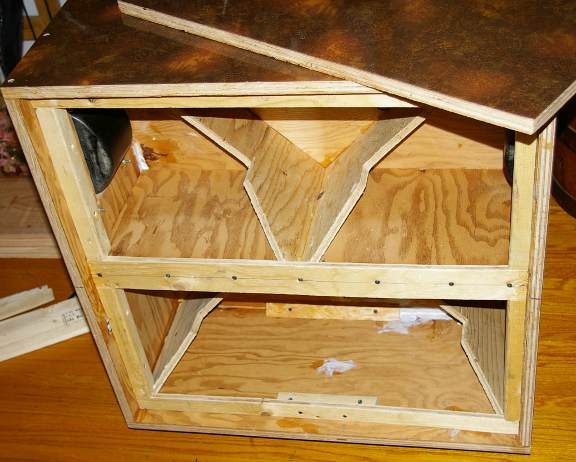
In this case, the bottom and top are still sounding a little like
the "Three Stooges Pop", so I'll need to dampen those two panels at least.
The side panels are stiff as a board, from the cross-divider.
I estimate I lost about a half a cubic foot of internal space adding these supports,
but I also gained most of it back by simply letting the 3/8" plywood front-panel supports to raise the front-panel forward over 3/8" (i.e., 3' x 3' front = 9 sq ft x 3/8").
thats the whole reason I started a thread.
Here is my build update:
Pic 1 shows me adding a permanent divide between the two sides.
This allows one 12" bass speaker to drive each side, and have its own box.

The divider is also 1" plywood from the same sheet of laminated tabletop I got free.
This makes the two sides totally independent, and also allows lots of glue-surface
and screw-down wood to sink into to hold both the front and back panels rigid,
and attached to each other across the center.
Pic 2 shows 2x2 (really 1.5 x 1.5" pine/spruce along the top and bottom edge
for sealing and screwing down the front plate(s).

Note also the chunk of 2" plywood triangle in the center back,
to give the screws on the back panel something to bite into.
Pic 3 shows a detail of some triangular glued supports to keep the sides and back connected.

Pic 4 below shows how a half-panel can be easily substituted to make the cabinet bass/guitar combo,
or for comparing different guitar speaker-pairs.
Panels can be put in vertically or horizontally, so for instance,
I only have to cut 2 12" holes, one in each panel to have a complete bass cabinet.
Extra panels are easy to make, for swapping in and out!

You will notice the rabbit has expressed his usual dim view of speaker projects.
In fact he is quite unimpressed with the slippery top, although it is water-proof,
and probably rabbit-proof too.
Pic 5 shows the bottom panel (same as top). They receive some stiffness from the side supports, but tapping various sides and compartment walls will reveal rattles, weak gluing, unusual resonance problems and/or areas needing more stiffness/support.

In this case, the bottom and top are still sounding a little like
the "Three Stooges Pop", so I'll need to dampen those two panels at least.
The side panels are stiff as a board, from the cross-divider.
I estimate I lost about a half a cubic foot of internal space adding these supports,
but I also gained most of it back by simply letting the 3/8" plywood front-panel supports to raise the front-panel forward over 3/8" (i.e., 3' x 3' front = 9 sq ft x 3/8").
Attachments
Last edited:
Because the front panel at the moment is 1" thick,
there is plenty of room for front-mounting speakers
and also sinking them into the top with a ridge/lip to make them flush with the front.
All the wood I got free so far, within a block and a half of my house.
The plywood tabletop I carried home, and probably would have
had to carry it the same distance to and from my car if I had bought it...
The other wood is from a dumpster bin at a house-reno down the street.
I got plenty of 3/8" plywood scraps and 2x2" strips, and 2x4 end-pieces,
and old (real) 2x4s too, for fixing my garage, which they were tossing.
My cost so far:
handles $9 each = $18.00 (Speaker Shop)
wheels $5 each = $20.00 (Home Depot)
screws $5?
One circular saw and extra fine blade $100.00 (however, I'll be using this for more projects!)
Also, I may buy a plunge-router (used at pawnshop) and blade to do speaker cutouts.
(estimate $50?)
Call it $150 in parts/tools, and a couple of days fooling around with son building it (priceless!)
They are selling a ready-made carpeted box with handles (no wheels) out of chipboard (no supports),
for about $160. So I'm still ahead, and its a great DIY project!
I would have had to do the same amount of reinforcing to the premade cabinet, and add wheels...
there is plenty of room for front-mounting speakers
and also sinking them into the top with a ridge/lip to make them flush with the front.
All the wood I got free so far, within a block and a half of my house.
The plywood tabletop I carried home, and probably would have
had to carry it the same distance to and from my car if I had bought it...
The other wood is from a dumpster bin at a house-reno down the street.
I got plenty of 3/8" plywood scraps and 2x2" strips, and 2x4 end-pieces,
and old (real) 2x4s too, for fixing my garage, which they were tossing.
My cost so far:
handles $9 each = $18.00 (Speaker Shop)
wheels $5 each = $20.00 (Home Depot)
screws $5?
One circular saw and extra fine blade $100.00 (however, I'll be using this for more projects!)
Also, I may buy a plunge-router (used at pawnshop) and blade to do speaker cutouts.
(estimate $50?)
Call it $150 in parts/tools, and a couple of days fooling around with son building it (priceless!)
They are selling a ready-made carpeted box with handles (no wheels) out of chipboard (no supports),
for about $160. So I'm still ahead, and its a great DIY project!
I would have had to do the same amount of reinforcing to the premade cabinet, and add wheels...
An amazing thing just happened.
I had emailed Jensen about bass speakers
that would be clean and uncolored.
They replied that guitar speakers nowadays
are designed for coloration and are made to 'break up' earlier,
while bass speakers were designed around minimizing distortion.
They recommended I go to another company, and look at their bass speakers.
I am floored.
It seems unheard of today that a company would happily
and honestly recommend another company's product,
in order to better meet a potential client's needs.
Thank you Jensen for your honesty and helpfulness.
Here is the speaker I was pointed to:
C12B25P
I haven't a clue about the price, but its fun to look!
aha:
119.95 at Amplified Parts.
I had emailed Jensen about bass speakers
that would be clean and uncolored.
They replied that guitar speakers nowadays
are designed for coloration and are made to 'break up' earlier,
while bass speakers were designed around minimizing distortion.
They recommended I go to another company, and look at their bass speakers.
I am floored.
It seems unheard of today that a company would happily
and honestly recommend another company's product,
in order to better meet a potential client's needs.
Thank you Jensen for your honesty and helpfulness.
Here is the speaker I was pointed to:
C12B25P
An externally hosted image should be here but it was not working when we last tested it.
General Characteristics Nominal Overall Diameter
Electrical Characteristics Nominal Impedance 318 mm
12 in
Nominal Voice Coil Diameter 65 mm
2.50 in
Magnet Weight 1450 g
50 oz
Overall Weight 10.58 lbs
Flux Density 1.15 T
Thiele-Small Parameters Voice Coil DC Resistance RE
6.00 ohms
Resonance Frequency ƒS
39.7 Hz
Mechanical Q Factor QMS
13.62
Electrical Q Factor QES
0.37
Total Q Factor QTS
0.36
Mechanical Moving Mass MMS
56.3 g
Mechanical Compliance CMS
285 µm/N
Force Factor BxL
15.12 Wb/m
Equivalent Acoustic Volume VAS
96.5 lt.
Maximum Linear Displacement XMAX
+/- 2.0 mm
Reference Efficiency nO
1.58 %
Diaphragm Area SD
490.9 cm2
Losses Electrical Resistance RES
221.6 ohms
Voice Coil Inductance @ 1kHz LE
0.94 mH
Constructive Characteristics Magnet Ferrite
Voice Coil Winding Copper
Voice Coil Former Kapton
Cone Paper
[FONT=Arial, Helvetica, sans-serif]Surround[/FONT] Treated Cloth
Dust Dome Solid Paper
Basket Pressed Sheet Steel
8 ohms
Rated Power 250 W
Musical Power 500 W
Sensitivity@1W, 1m 95.2 dB
An externally hosted image should be here but it was not working when we last tested it.
An externally hosted image should be here but it was not working when we last tested it.
I haven't a clue about the price, but its fun to look!
aha:
119.95 at Amplified Parts.
Last edited:
While fumbling about over speaker-holes,
I found this great DIY page on how to use a router
to cut speaker-holes and insets. Its incredibly detailed,
and he documents all the problems and mistakes
one is likely to run into trying to do your own speaker-holes.
Speaker Enclosure Volume Calculator
Don't be put off by the first 1/3 of the page.
Scroll down for amazing detailed descriptions on HOW TO CUT SPEAKER HOLES.
I found this great DIY page on how to use a router
to cut speaker-holes and insets. Its incredibly detailed,
and he documents all the problems and mistakes
one is likely to run into trying to do your own speaker-holes.
Speaker Enclosure Volume Calculator
Don't be put off by the first 1/3 of the page.
Scroll down for amazing detailed descriptions on HOW TO CUT SPEAKER HOLES.
The driver you posted has rather minimal Xmax. If the Xlim is still of decent size, this may not matter too much. You'll get increasing harmonic distortion at the lower frequencies when turned up.
Speaker Detail | Eminence Speaker
Might fit the bill - reasonably priced, 4mm Xmax (11mm Xlim) one way, plenty of power handling, T/S parameters would get you reasonable output in your cabinet, and the sensitivity is usefully high.
Think I'd still go for 4x10" over 2x12". If nothing else, the 4x10" will move more air. Each to his own.
Chris
Speaker Detail | Eminence Speaker
Might fit the bill - reasonably priced, 4mm Xmax (11mm Xlim) one way, plenty of power handling, T/S parameters would get you reasonable output in your cabinet, and the sensitivity is usefully high.
Think I'd still go for 4x10" over 2x12". If nothing else, the 4x10" will move more air. Each to his own.
Chris
As I recall, the Celestion Blue (G12) was their first guitar speaker, basically the 15 watt 12" alnico speaker they were selling for console radios (which were also open-backed). Famously used in Vox AC30s and AC15s, they were also used by Marshall at first. As ceramic magnets came down in price, they debuted the G12M "Greenback". With a heavier cone and suspension, these could take more power, which was a good thing as 50 watt Marshalls can put out close to 90 watts when dimed. Later, they beefed up the magnet, added the heavier cones from their bass speakers (hence the 75Hz and 55 Hz designations), and the G12H was born.The greenback/blueback is the definitive/first ever guitar speaker made by celestion, as a result, EVERYTHING else is going to be loosely based on it.
If someone wants to use Google and correct me, feel free. 😉
But basically, yeh, you're quite right. Just as Gibson would like everyone to believe their current Les Pauls sound just like the 'Bursts of the '50s, Celestion has been trying to keep the tone they're famous for, while keeping up with the changes in amps and music.
Last edited:
re:10" when Eminence redesigned their B102 to a smaller magnet and different surround there was quite a bit of midrange and "highs" lost - in practice I'm not sure how this matters on bass as never bothered to play a bass through either.
re:12L - is the new model the same as the old with regards to T-S and "tone"? - I'd like to try one or 12PE32 in a little Karlson
B102 old vs new with each on-axis in a floor vented direct radiator pipe
re:12L - is the new model the same as the old with regards to T-S and "tone"? - I'd like to try one or 12PE32 in a little Karlson
B102 old vs new with each on-axis in a floor vented direct radiator pipe
An externally hosted image should be here but it was not working when we last tested it.
Naz , that is one heck of a big rabbit!
Great looking cab. What's the current internal volume?
Still basically the same measurements:
28 x 28.3 x 11" = 8716.4 cu in = 5.04 ft³
minus about .5 cu ft so = 4.5 cu ft approx
so 2.25 cu ft per 12" woofer if I go bass cab.
Okay, seriously, I just looked in my garage,
and the previous tenant left an old bass cab (for car?).
In it were two 12" "SUPER PRO Super Blue" Made in USA speakers!
Both had their rubber surrounds torn loose,
and both were re-glued with a hot-glue gun!
This will have to be re-done.
But still:
Here are the original specs:
PW 1258-US (12" 8 ohm version)
They sell both at Parts Express for about $49.75
*
Power handling: 300 watts RMS *
VCdia: 2" *
Znom: 8 ohms *
Frequency response: 40-3,000 Hz *
Fs: 26.29 Hz *
SPL: 90 dB 1W/1m *
Vas: 7.54 cu. ft. *
Qms: 9.94 *
Qes: .36 *
Qts: .35 *
Xmax: 4.6mm *
Net weight: 9-1/8 lbs.
Suitable for woofer or subwoofer duty.
Here is the blurb for the 4 ohm version:
The Super Blue Series features a heavy duty blue
polymer laminate paper cone with a butyl rubber surround
for long life and durability.
The combination of 2" Kapton voice coil,
extended bump plate and vented magnet structure
allows for high power handling capability and high SPLs!
Ideal for all high performance car audio applications.
Made in the U.S.A.
Specifications: *
Power handling: 250 watts RMS/355 watts max. *
Voice coil diameter: 2" *
Impedance: 4 ohms *
Frequency response: 30-1,800 Hz *
Magnet weight: 50 oz. *
Fs: 27 Hz *
SPL: 94 dB 1W/1m *
Vas: 8.11cu. ft. *
Qms: 8.74 *
Qes: .31 *
Qts: .30 *
Xmax: 4.6mm *
Net weight: 10 lbs. *
Manufacturer model number: PW1254-US *
Dimensions: Overall Diameter: 12-1/8",
Cutout Diameter: 11",
Mounting Depth: 5-1/4",
Magnet Diameter: 5-1/4",
Magnet Height: 1-3/4".
So, all I have to do is figure out how to re-do the surrounds properly, and bingo,
I think I have some bass speakers to try out in the cab!
Hmmm....looking twice at the construction of the surrounds,
I think this is a good argument for NOT front-mounting a bass speaker.
Had they been mounted to the panel from the back, the surrounds would have been pinned,
between the cardboard grommet, and the metal frame.
and probably wouldn't have torn off.
(possibly outdoor use was a contributing factor too,
because there appears an undue amount of rust on the metal cage where the glue was.
Rain?)
---------
Since these only seem to go up to about 2 kHz sensibly,
I was thinking of pairing each one off with a tweeter,
and a xover at 2 kHz:

NEW PYLE TW46 1 1/2" 400W HEAVY DUTY TITANIUM DOME TWEETER 400 WATT 1.5"
($39.00 on Ebay)
Do you think this is a good match?
also, whats a good glue for butyl rubber surround / metal frame?
and the previous tenant left an old bass cab (for car?).
In it were two 12" "SUPER PRO Super Blue" Made in USA speakers!
Both had their rubber surrounds torn loose,
and both were re-glued with a hot-glue gun!
This will have to be re-done.
But still:
An externally hosted image should be here but it was not working when we last tested it.
Here are the original specs:
PW 1258-US (12" 8 ohm version)
They sell both at Parts Express for about $49.75
*
Power handling: 300 watts RMS *
VCdia: 2" *
Znom: 8 ohms *
Frequency response: 40-3,000 Hz *
Fs: 26.29 Hz *
SPL: 90 dB 1W/1m *
Vas: 7.54 cu. ft. *
Qms: 9.94 *
Qes: .36 *
Qts: .35 *
Xmax: 4.6mm *
Net weight: 9-1/8 lbs.
Suitable for woofer or subwoofer duty.
Here is the blurb for the 4 ohm version:
The Super Blue Series features a heavy duty blue
polymer laminate paper cone with a butyl rubber surround
for long life and durability.
The combination of 2" Kapton voice coil,
extended bump plate and vented magnet structure
allows for high power handling capability and high SPLs!
Ideal for all high performance car audio applications.
Made in the U.S.A.
Specifications: *
Power handling: 250 watts RMS/355 watts max. *
Voice coil diameter: 2" *
Impedance: 4 ohms *
Frequency response: 30-1,800 Hz *
Magnet weight: 50 oz. *
Fs: 27 Hz *
SPL: 94 dB 1W/1m *
Vas: 8.11cu. ft. *
Qms: 8.74 *
Qes: .31 *
Qts: .30 *
Xmax: 4.6mm *
Net weight: 10 lbs. *
Manufacturer model number: PW1254-US *
Dimensions: Overall Diameter: 12-1/8",
Cutout Diameter: 11",
Mounting Depth: 5-1/4",
Magnet Diameter: 5-1/4",
Magnet Height: 1-3/4".
So, all I have to do is figure out how to re-do the surrounds properly, and bingo,
I think I have some bass speakers to try out in the cab!
Hmmm....looking twice at the construction of the surrounds,
I think this is a good argument for NOT front-mounting a bass speaker.
Had they been mounted to the panel from the back, the surrounds would have been pinned,
between the cardboard grommet, and the metal frame.
and probably wouldn't have torn off.
(possibly outdoor use was a contributing factor too,
because there appears an undue amount of rust on the metal cage where the glue was.
Rain?)
---------
Since these only seem to go up to about 2 kHz sensibly,
I was thinking of pairing each one off with a tweeter,
and a xover at 2 kHz:
NEW PYLE TW46 1 1/2" 400W HEAVY DUTY TITANIUM DOME TWEETER 400 WATT 1.5"
($39.00 on Ebay)
Do you think this is a good match?
also, whats a good glue for butyl rubber surround / metal frame?
Last edited:
yes the blue, then the green. This is why i said in your presence keriwena 🙂 i cant hold on to much schpiele anymore !
I spent quite a bit of time working in a guitar shop, and since I'm too old to be pretty, I needed to know my stuff to be taken seriously. 
Nazaroo, the half-roll surrounds suggest those speakers have linear suspensions. That means if you pop or slap a string, they might bottom out. Or the surrounds might tear (again). Be careful with how much power you feed them.
2.25 cubic feet isn't a lot of room for a bass speaker. Keep in mind though, you don't have to go down to 41 Hz because the bass guitar doesn't. Not really. 😉

Nazaroo, the half-roll surrounds suggest those speakers have linear suspensions. That means if you pop or slap a string, they might bottom out. Or the surrounds might tear (again). Be careful with how much power you feed them.
2.25 cubic feet isn't a lot of room for a bass speaker. Keep in mind though, you don't have to go down to 41 Hz because the bass guitar doesn't. Not really. 😉
I spent quite a bit of time working in a guitar shop, and since I'm too old to be pretty, I needed to know my stuff to be taken seriously.
Nazaroo, the half-roll surrounds suggest those speakers have linear suspensions. That means if you pop or slap a string, they might bottom out. Or the surrounds might tear (again). Be careful with how much power you feed them.
2.25 cubic feet isn't a lot of room for a bass speaker. Keep in mind though, you don't have to go down to 41 Hz because the bass guitar doesn't. Not really. 😉
Thanks for this tip about slaps and pops.
I am now thinking of instead using these speakers for the bottom end of my playbacks (filling out the small 6.5" mids and tweets).
Then I would maybe go for the ones previously posted:
12" Bass woofer 350 watts RMS ( x 2 = 700 watts!)
MCM Professional Woofer
$47.57 ...... ( x 2 = $96.00 unfortunately Plus shipping...)
An externally hosted image should be here but it was not working when we last tested it.
These ones seem to be actually the best for 4 or even 5-string bass.
Is that a better way of going?
Also, with these speakers,
what do you think of a crossover and tweet,
like the one in my previous post?
my experience of high power Car or home hi-fi woofers used in a musical amp/PA are that whilst it can sound really really good, those type of drivers just don't tolerate the same level of abuse that a purpose designed driver can. That doesn't encompass ALL ICE drivers, But i still like my original idea. Use the guitar for guitar, and make a 15" cab to sit under it. Use the guitar drivers/or some of them, for tone; with an HP filter to save them from slaps. You could conceiveably play with a single 15", but that depends how 'dark' you like your bass guitar to sound, OR if you can find one with a good response. I dont believe a bullet tweeter is a requirement for a bass cab, as long as you can cover up to maybe 10khz, then im sure it would be bright enough, and anything else above that would likely just be 'hiss'. Using the guitar cab as a 'tweeter' high passed at say, 500 hz-1 khz, just first order with a single cap, that could be enough to experiment with.
Last edited:
Those MCMs look pretty good. Cast basket, accordion surround, vented...
Have you seen this page?
http://greenboy.us/fEARful/
You'll find a lot of answers there. Proven designs, sort of a group effort by the guys on TalkBass forum.
Have you seen this page?
http://greenboy.us/fEARful/
You'll find a lot of answers there. Proven designs, sort of a group effort by the guys on TalkBass forum.
- Status
- Not open for further replies.
- Home
- Loudspeakers
- Full Range
- Homemade Marshall cabinet - how to port? what speakers?

